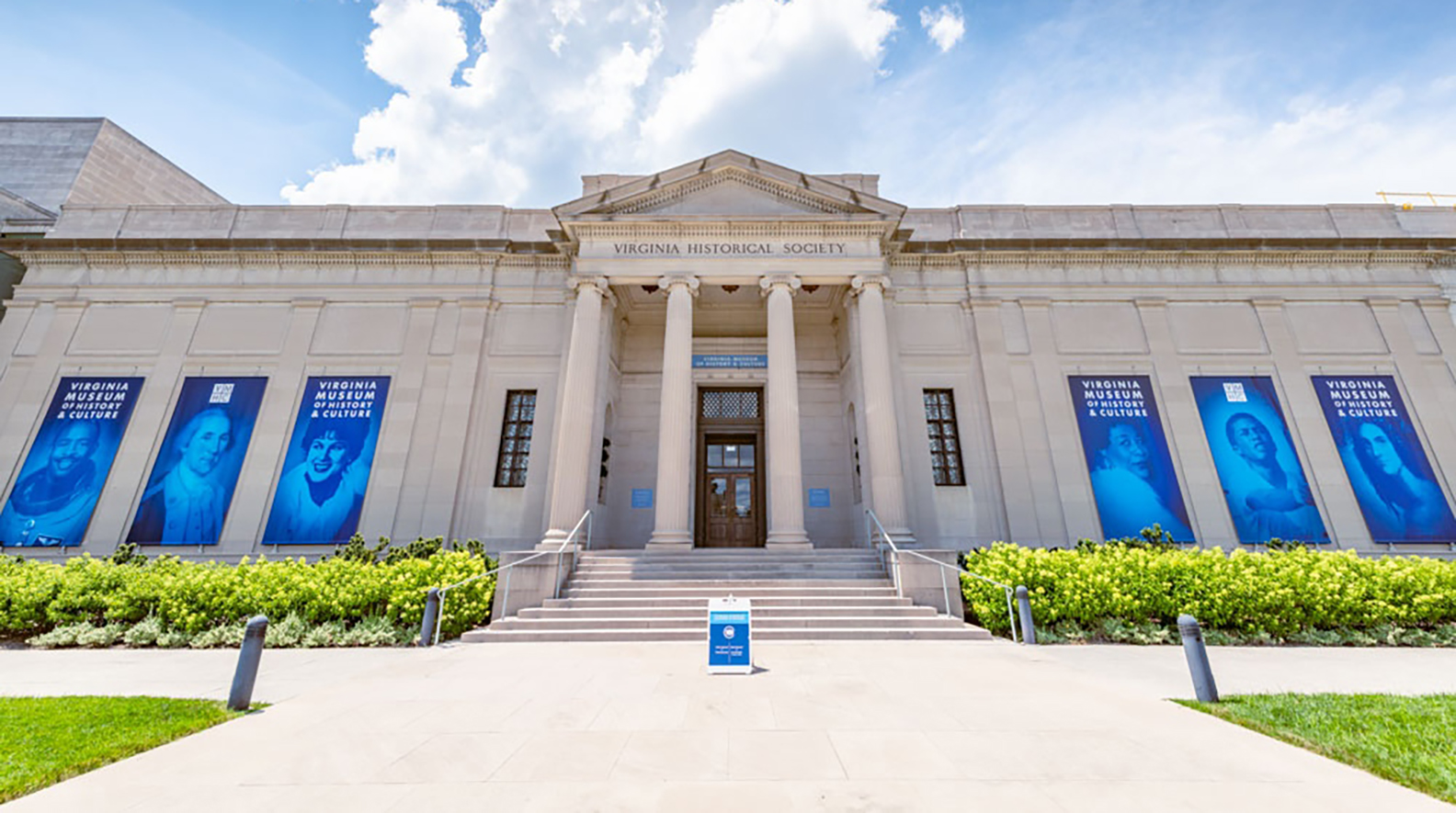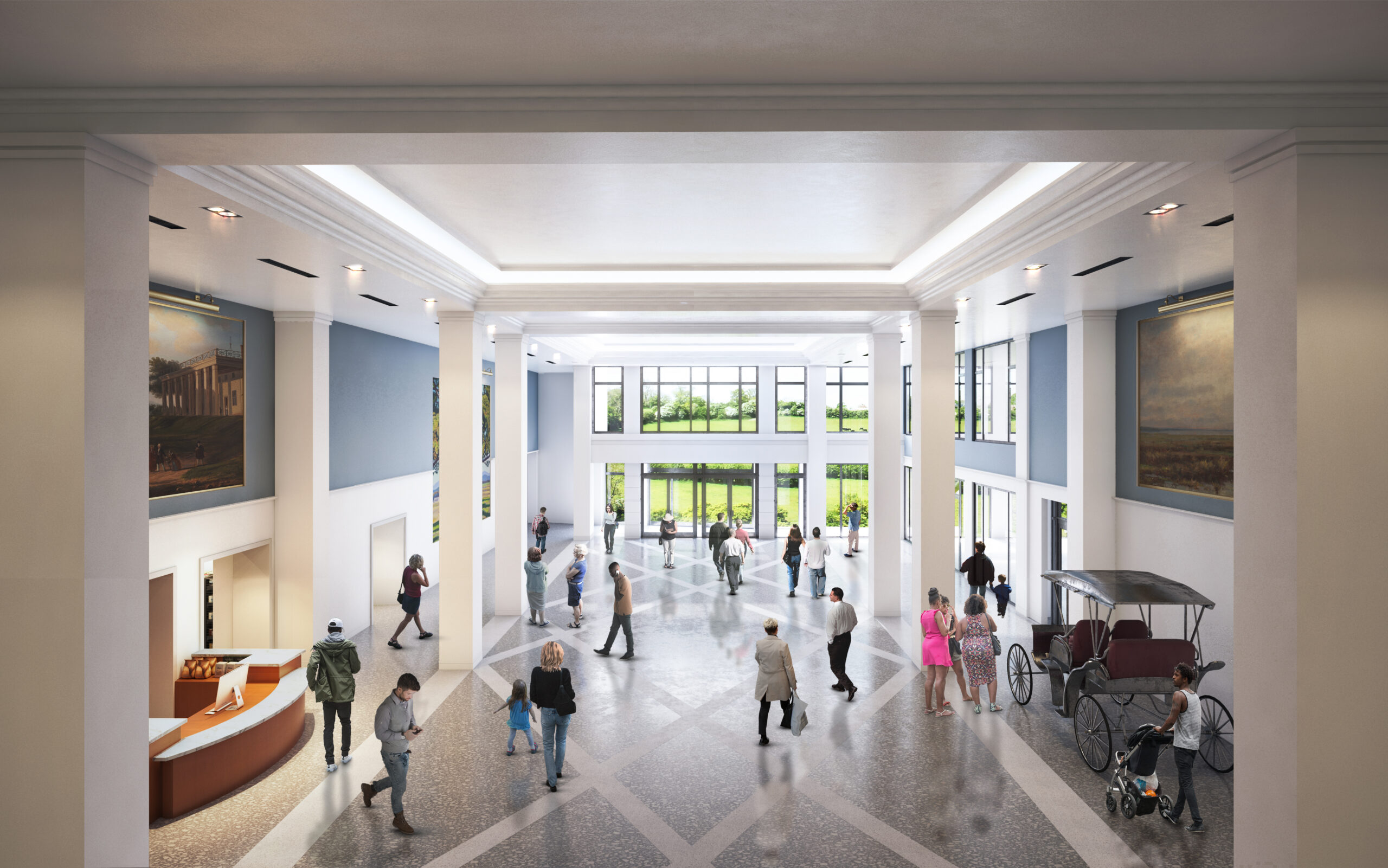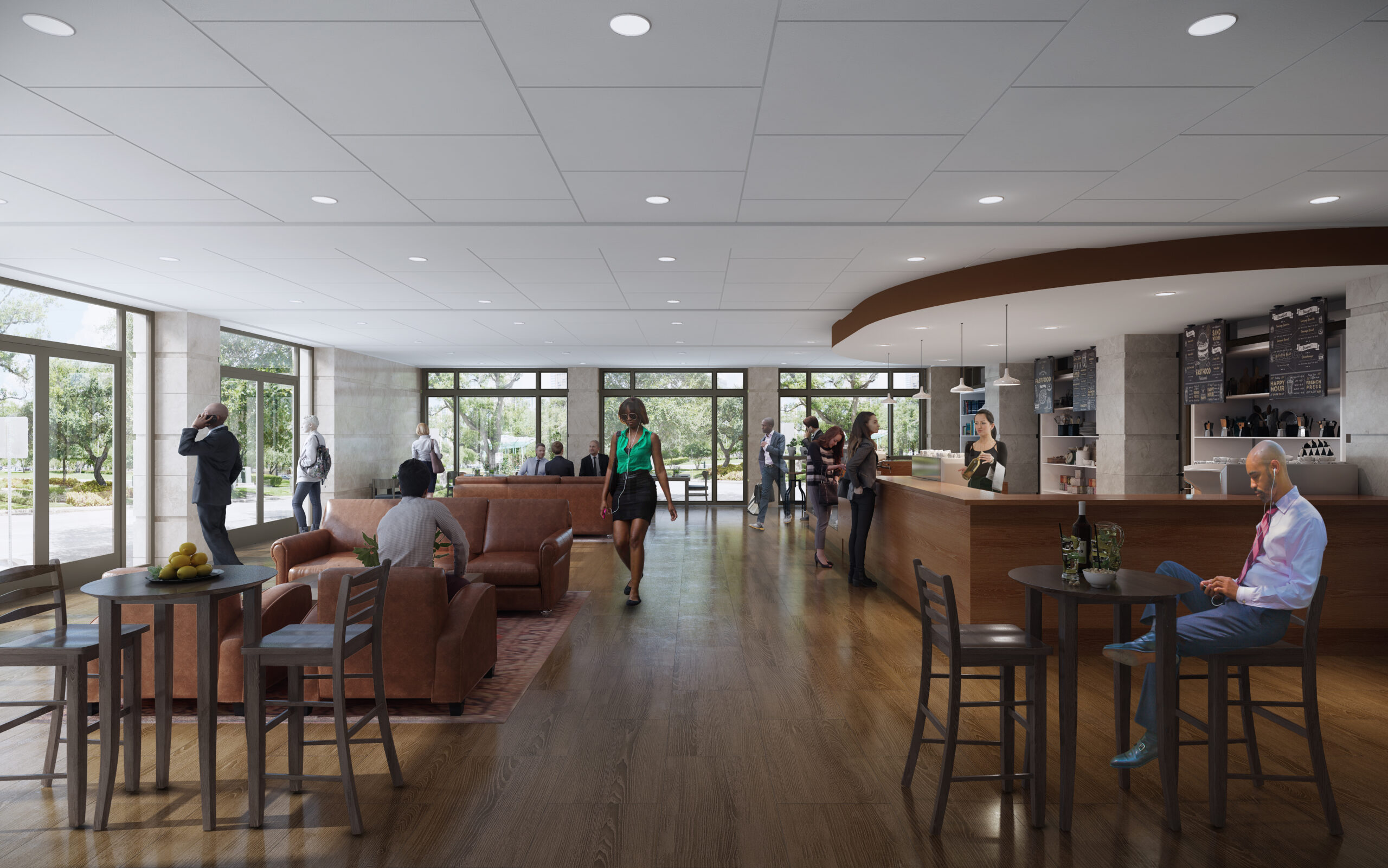
The Virginia Museum of History & Culture on Arthur Ashe Boulevard. (Courtesy of the Virginia Museum of History & Culture)
The Virginia Museum of History & Culture occupies one of our community’s grandest edifices. The elegant 1910s Greek Revival temple front, with four colossal Ionic columns and flanking pier columns, reigns over Arthur Ashe Boulevard from atop a terraced lawn.
In May, the venerable historical and educational institution, which Chief Justice John Marshall founded in 1831, unveiled a reconceived, 250,000-square-foot, $30 million museum and research center. The front facade remains unchanged, but the expansion is evident at the rear where a cafe, surface parking, a visitor drop-off, an events green space, and a clean-cut looking, two-story entrance pavilion, Commonwealth Hall, beckon. Deeper inside the stoic-looking building, major physical changes included a reworked research library and expanded exhibition, educational and meeting spaces.
Since the building’s reopening, many folks have expressed surprise that the reconfiguration and construction had even been underway during the past year or so. Apparently, throughout the depths of the pandemic, the VMHC, its architect Glave & Holmes, and design and construction teams were in high gear creating a refreshed environment. The interior walls are painted mostly white with accents in soothing shades of blue. In fact, even the institutional logo, promotional materials, and staff T-shirts are blue. Even after dark, the sandstone front facade appears lightly washed with soft blue light. The result? You know that you are within the realm of a new VMHC.
These crisp and conservative architectural changes are perhaps the sixth or seventh expansion since the classical building was completed in 1914, most of them designed by Glave & Holmes.
It’s therefore timely to recall pieces of the architectural history of the place. The six-acre VMHC complex remains inextricably linked to the larger grounds of a former late-19th century retirement community for Confederate veterans and their wives, sisters and daughters. In the 1880s, the Commonwealth of Virginia acquired the former farmland situated just west of the city limits to house the veterans. Today, four buildings remain of that complex: The Robinson House, the Confederate Chapel, and the Pauley Education Center (formerly the Confederate home for Needy Women). They are now components of the Virginia Museum of Fine Arts, which opened next door in 1935. The original core of the VMHS building was built in part to serve as a repository for the documents, weapons, and ephemera the veterans brought to the retirement home.
The mausoleum-like building was called the Battle Abbey and was a big deal at its inception. In 1910, an international competition accepted proposals from 88 leading architectural firms. The two Richmond architects in the mix, W. Duncan Lee and Charles M. Robinson, didn’t make the final cut. Neither did other firms with strong Virginia connections such as Bostonian Ralph Adams Cram (who had begun designing the University of Richmond in 1910) and New York talents Walter Blair (the designer of a dozen structures at the University of Virginia, including Scott Stadium) and J. Stewart Barney, the architect of All Saints and Holy Trinity Episcopal churches here (both demolished).
The prestigious commission went to a Philadelphia firm, Bissell & Sinkler. Elliston Sinkler had studied at the University of Pennsylvania and John Sinkler tackled his classical architectural studies at the Ecole des Beaux-Arts in Paris, the gold standard school for western architects during the Gilded Age.
The generous and eccentric financial underwriter of the Battle Abbey was Maryland-born Charles Broadway Rauss. He was a New York retail tycoon who had grown up near Winchester, Virginia, and been successful in retail there before enlisting with the Confederate army. After the war, in Horatio Alger form, Rauss made his way to New York City where, penniless, he served time briefly in debtors’ prison. However, he eventually formed a hugely successful retail operation in Soho on Broadway. Changing his middle name was an affectation.
His company mantra was: “We shall keep everything calculated to make a man fashionable, a lady irresistible, and a family comfortable.”
Rauss, who was married, lost his eyesight by middle age but his romantic pursuits apparently didn’t wane. When he died in 1900, at least two former mistresses made claims on his estate. One sought $100,000 for her son whom she had named Charles Broadway Rousseau. The judge awarded her that sum plus $5,766.16 in interest. Apparently love is not blind.
Rauss left $100,000 for construction of the Battle Abbey (the city of Richmond also made a major gift). The merchant also bequeathed funds for a city hall and waterworks in Winchester. For a park on New York City’s upper west side, he donated a double statue of George Washington and Lafayette by the Italian artist Frederic-Auguste Bartholdi (sculptor of the Statue of Liberty).
Initially and through the years, a major draw to the Battle Abbey were dramatic and large murals depicting the Confederate military by French painter Charles Hoffbauer. These were the gift of another Virginia poor boy-turned famously wealthy, Thomas Fortune Ryan. The Amherst County native made his mark by consolidating competing New York rail companies into a single electric streetcar system. He also owned the Equitable Life Insurance Co. and was a founder of the American Tobacco Co. In 1906, Ryan and his wife had provided funds to build the Cathedral of Sacred Heart overlooking Richmond’s Monroe Park.
Hoffbauer’s Ryan-funded murals have been conserved and pop with colorful and certain intensity in the Memorial Military Gallery. A newcomer to the gallery is a bronze statue of Robert E. Lee which previously stood in Statuary Hall in the United States Capitol. Interestingly, the collections of the Virginia Historical Society, the parent of the VMHC, were previously housed in the Robert E. Lee house on East Franklin Street before moving to the Battle Abbey in 1947.
The scope of the VMHS collections is broad and ranges in topic from Native American culture to colonial times, the American Revolution, enslaved peoples, the Civil War, industrial and transportation developments, the Civil Rights movement and the distinct geographic regions of Virginia. In an era of cultural amalgamation, it’s a good place to make your own determination about what makes Virginia, well, Virginia.

The Virginia Museum of History & Culture on Arthur Ashe Boulevard. (Courtesy of the Virginia Museum of History & Culture)
The Virginia Museum of History & Culture occupies one of our community’s grandest edifices. The elegant 1910s Greek Revival temple front, with four colossal Ionic columns and flanking pier columns, reigns over Arthur Ashe Boulevard from atop a terraced lawn.
In May, the venerable historical and educational institution, which Chief Justice John Marshall founded in 1831, unveiled a reconceived, 250,000-square-foot, $30 million museum and research center. The front facade remains unchanged, but the expansion is evident at the rear where a cafe, surface parking, a visitor drop-off, an events green space, and a clean-cut looking, two-story entrance pavilion, Commonwealth Hall, beckon. Deeper inside the stoic-looking building, major physical changes included a reworked research library and expanded exhibition, educational and meeting spaces.
Since the building’s reopening, many folks have expressed surprise that the reconfiguration and construction had even been underway during the past year or so. Apparently, throughout the depths of the pandemic, the VMHC, its architect Glave & Holmes, and design and construction teams were in high gear creating a refreshed environment. The interior walls are painted mostly white with accents in soothing shades of blue. In fact, even the institutional logo, promotional materials, and staff T-shirts are blue. Even after dark, the sandstone front facade appears lightly washed with soft blue light. The result? You know that you are within the realm of a new VMHC.
These crisp and conservative architectural changes are perhaps the sixth or seventh expansion since the classical building was completed in 1914, most of them designed by Glave & Holmes.
It’s therefore timely to recall pieces of the architectural history of the place. The six-acre VMHC complex remains inextricably linked to the larger grounds of a former late-19th century retirement community for Confederate veterans and their wives, sisters and daughters. In the 1880s, the Commonwealth of Virginia acquired the former farmland situated just west of the city limits to house the veterans. Today, four buildings remain of that complex: The Robinson House, the Confederate Chapel, and the Pauley Education Center (formerly the Confederate home for Needy Women). They are now components of the Virginia Museum of Fine Arts, which opened next door in 1935. The original core of the VMHS building was built in part to serve as a repository for the documents, weapons, and ephemera the veterans brought to the retirement home.
The mausoleum-like building was called the Battle Abbey and was a big deal at its inception. In 1910, an international competition accepted proposals from 88 leading architectural firms. The two Richmond architects in the mix, W. Duncan Lee and Charles M. Robinson, didn’t make the final cut. Neither did other firms with strong Virginia connections such as Bostonian Ralph Adams Cram (who had begun designing the University of Richmond in 1910) and New York talents Walter Blair (the designer of a dozen structures at the University of Virginia, including Scott Stadium) and J. Stewart Barney, the architect of All Saints and Holy Trinity Episcopal churches here (both demolished).
The prestigious commission went to a Philadelphia firm, Bissell & Sinkler. Elliston Sinkler had studied at the University of Pennsylvania and John Sinkler tackled his classical architectural studies at the Ecole des Beaux-Arts in Paris, the gold standard school for western architects during the Gilded Age.
The generous and eccentric financial underwriter of the Battle Abbey was Maryland-born Charles Broadway Rauss. He was a New York retail tycoon who had grown up near Winchester, Virginia, and been successful in retail there before enlisting with the Confederate army. After the war, in Horatio Alger form, Rauss made his way to New York City where, penniless, he served time briefly in debtors’ prison. However, he eventually formed a hugely successful retail operation in Soho on Broadway. Changing his middle name was an affectation.
His company mantra was: “We shall keep everything calculated to make a man fashionable, a lady irresistible, and a family comfortable.”
Rauss, who was married, lost his eyesight by middle age but his romantic pursuits apparently didn’t wane. When he died in 1900, at least two former mistresses made claims on his estate. One sought $100,000 for her son whom she had named Charles Broadway Rousseau. The judge awarded her that sum plus $5,766.16 in interest. Apparently love is not blind.
Rauss left $100,000 for construction of the Battle Abbey (the city of Richmond also made a major gift). The merchant also bequeathed funds for a city hall and waterworks in Winchester. For a park on New York City’s upper west side, he donated a double statue of George Washington and Lafayette by the Italian artist Frederic-Auguste Bartholdi (sculptor of the Statue of Liberty).
Initially and through the years, a major draw to the Battle Abbey were dramatic and large murals depicting the Confederate military by French painter Charles Hoffbauer. These were the gift of another Virginia poor boy-turned famously wealthy, Thomas Fortune Ryan. The Amherst County native made his mark by consolidating competing New York rail companies into a single electric streetcar system. He also owned the Equitable Life Insurance Co. and was a founder of the American Tobacco Co. In 1906, Ryan and his wife had provided funds to build the Cathedral of Sacred Heart overlooking Richmond’s Monroe Park.
Hoffbauer’s Ryan-funded murals have been conserved and pop with colorful and certain intensity in the Memorial Military Gallery. A newcomer to the gallery is a bronze statue of Robert E. Lee which previously stood in Statuary Hall in the United States Capitol. Interestingly, the collections of the Virginia Historical Society, the parent of the VMHC, were previously housed in the Robert E. Lee house on East Franklin Street before moving to the Battle Abbey in 1947.
The scope of the VMHS collections is broad and ranges in topic from Native American culture to colonial times, the American Revolution, enslaved peoples, the Civil War, industrial and transportation developments, the Civil Rights movement and the distinct geographic regions of Virginia. In an era of cultural amalgamation, it’s a good place to make your own determination about what makes Virginia, well, Virginia.


Humble thanks to Professor Slipek for another wonderful piece detailing the history of an important RVA institution. The expanded VMHC is indeed a jewel in the crown that is Richmond’s collection of grand, world-class museums. Without question, RVA punches WELL above her weight for a city of her size (in actual population) when it comes to the size, scope, depth, quality and grandeur of her museums, boasting institutions normally found in much larger cities such as Washington, DC, NYC or Chicago. We should all take great pride in – and feel a sense of gratitude for – such iconic cultural… Read more »
Charles Broadway Rouss. See https://sohobroadway.org/a-look-back-at-sohos-broadway-broadway-was-his-middle-name/